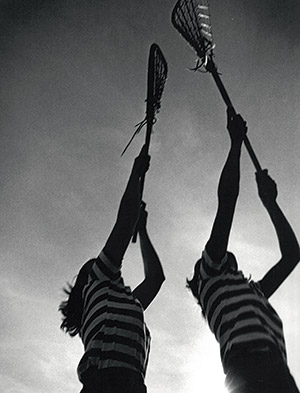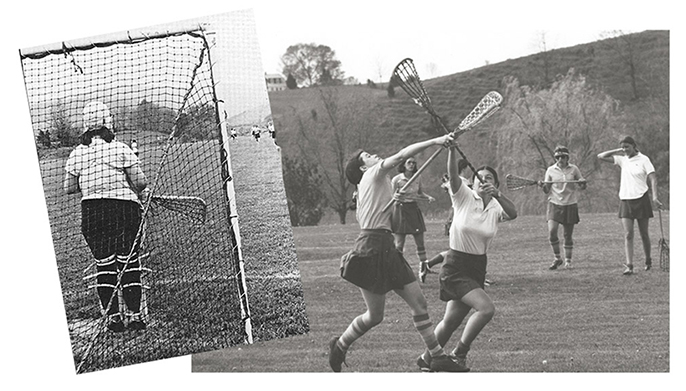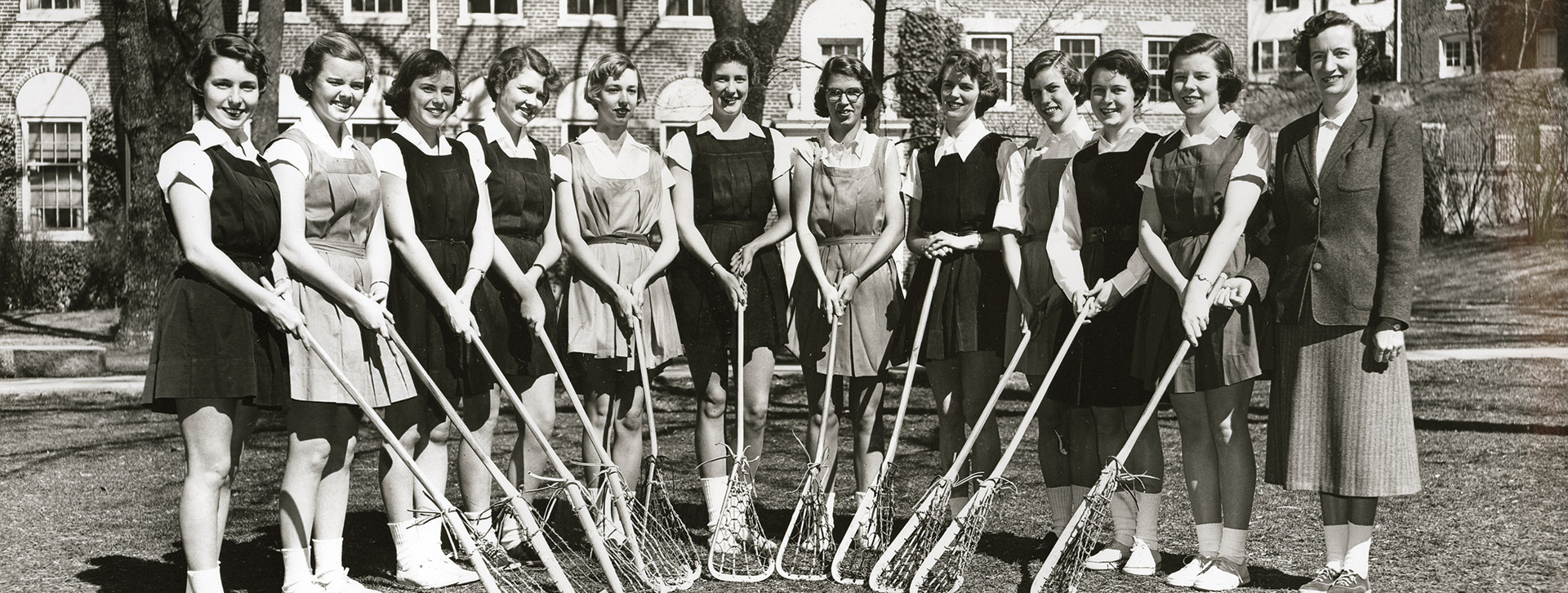“Things Flowed So Much Easier”
THE LEGACY OF LACROSSE AT HOLLINS
By Billy Faires
Above: 1954 team photo
In the early afternoon hours of Sunday, May 14, 1979, the weather was close to perfect. Perhaps a bit on the warm side.
Hollins—the home team, the host team, welcoming schools from across the country for the Division II Lacrosse National Championships—entered halftime of the finals with a 3-1 lead over second-seeded Lock Haven State.

1979 photo
Hollins rolled into the finals on “College Field 2” – Field 1, which would later be named for beloved longtime coach Marjorie Berkley, was unplayable due to a thunderstorm earlier that day* – having walloped their first two opponents. They first plastered the University of Richmond 16-3 in the quarters, and then Cortland (now SUNY Cortland) 9-2 in the semifinals.
Everything seemed to favor the Green and Gold. Head Coach Lanetta Ware, who today is professor of physical education emeritus, was in her 16th season at Hollins, a tenure marked by numerous undefeated seasons and regularly competing with, often besting, better-knowns like Dartmouth and even home-state rival University of Virginia*.
Her team included a handful of first- and second-team All Virginia talent, led by All-American Leslie Blankin Lane ’79, a four-sport super-athlete who would go on to play on the United States’ Women’s National Team* for lacrosse in 1982, where she would earn All-World honors as a midfielder on that gold medal team.
Ware’s team emerged from halftime and quickly built on their momentum, scoring a fourth goal barely a minute into the second half. They wouldn’t score again for the remainder of the game.
A high-speed, no-holds-barred barrage by Lock Haven commenced, and despite 19 saves by first-year student and goalie Lee Canby ’82, the game was tied with just under 15 minutes remaining. Lock Haven’s winning goal came just two minutes later, and the 5-4 score would hold the remainder of the time.
“When you play a top-level opponent, you have to be at top speed all the time, particularly when you have the ball,” Ware told the Roanoke Times & World News, and the opposing coach noted that they picked up the key loose balls in the midfield in the second half. “And a lot of times, that’s where a game is won.”
No one on that field, or in the audience crowded around it, or living in the dorms or on Faculty Row, could have known that May 14, 1979, would be the pinnacle of Hollins lacrosse.
Ware’s early ’80s teams remained intensely competitive, although they never returned to the nationals. The coach, who led the team to two Virginia state championships in addition to coming up a goal shy of a national title, would retire from coaching Hollins lacrosse in 1984* to become an internationally rated and revered lacrosse umpire. Her 28-year officiating career would find her serving as head technical delegate for the 1986 and 1989 World Cups, among other career highlights. Ware’s leadership in the women’s lacrosse world would only grow, and she eventually served eight years as the president of the International Federation of Women’s Lacrosse Associations (IFWLA) from 1993 to 2001.

Left: “The Rock” Christi Hays ’74 in goal. Right: 1975 game photo
Forty-four years after that loss in the national finals, in February 2023, Hollins announced its decision to discontinue the program. Lacrosse at Hollins had begun facing roster challenges and coaching consistency in the late 1980s, and by the late 2000s it was fighting to survive. Hollins struggled to find a coach who could right the ship with recruiting and victories. By 2016, the once proud and successful program had requested a temporary reprieve from the Old Dominion Athletic Conference to step away from conference competition due to the inability to field a full and competitive roster.
After an extension of that waiver in 2018, and another to 2022, it was clear the team could not “reach a roster size that would allow us to sufficiently compete and to ensure the health and safety of our student-athletes,” as Athletic Director Chris Kilcoyne noted in the announcement. Lacrosse at Hollins spanned over 70 years, beginning in 1952, and left its imprint on the lives of hundreds of Hollins alumnae and their families.
Nancy Dick ’62 picked up her first lacrosse stick in 1947 when she was just seven years old. Her home at Washington College in Maryland was “mere steps away” from where the men’s lacrosse team practiced and played. “I became the team’s informal mascot,” she said.
Dick entered Hollins as a legacy, following her mother Dorothy Quarles Dick ’30, and was a four-sport athlete as a student.
“The athletics were great at Hollins, and I loved being able to do all those things all year ‘round,” Dick said. “For one thing, I had a lot of energy, and I needed to get it out! I loved the camaraderie of being on a team, and it was very different from being in a classroom. I was a fine student, but not Phi Beta Kappa or anything. But every afternoon I was out there somewhere on a field or a court, practicing. I was so very team-sport oriented.”
Ware began her Hollins coaching career the year after Dick graduated, in 1963.
Coach Ware’s teams lost only one game during her first four seasons at Hollins, going undefeated in 1963, 1965, and 1966.
“They were what I called a push-button team,” Ware recalled. “All I had to do was get them in good shape and get them to cooperate with each other and place them on the field properly for their talents. They did the rest.”
Ware noted Deborah Snyder “Snickie” Bussart ’65 as “one of the first really great players I ever had. She and Ann Howson Dixon ’65 had played together in high school, and they could hit one another on the run going down the field and never miss a stride and go to goal no problem.”
In 1967, women’s lacrosse had begun to expand to other schools in Virginia and beyond, and the competition for players increased. Going undefeated became an increasingly difficult bar to reach. “As the years went on,” Ware said, “I knew we’d have to start using fillers who hadn’t come to Hollins playing lacrosse, so I had to find athletes and work with them to fill in those spots to make a competitive team.”
Mary Willson Pinder Schill ’73* was just such an example. She had never played team lacrosse before coming to Hollins, but Ware noted her athleticism and recruited her. Lacrosse quickly became Schill’s “favorite sport of all time.”
“Back then, there were so few rules (to women’s lacrosse), and you played with natural boundaries. You could just go anywhere, and the ball would just soar,” she said. “I was an attack wing, so my job was to get the defense to the offense, and my job was to pass to Anne Grauer ’71, because she could score from anywhere.”
Christi Hays ’74, just a year behind Schill, was crushed when Denison turned her down, a rejection which led to her attending Hollins. She thought, as teenagers with dreams so often do, that her life was over at that point.
“What I didn’t know was that my life as I know it still today was just beginning. Going to Hollins turned out to be the best thing that ever happened to me,” Hays said.
Hays’ cousin is Carol Semple Thompson ’70, who was known affectionately and respectfully as “The Hulk,” and who went on to become one of the greatest amateur golfers of all time. Following in Thompson’s footsteps was a little frightening for Hays, even though the latter was a five-sport athlete in high school. But it didn’t take her long to leave an impression on her classmates, quickly earning the nickname “Hulk Jr.” before earning one that stuck for life: “Rock.”
“I know it was because of the way I was built,” Hays said, “but I like to think it was because I was steady and reliable in the goal! Admittedly you have to be a little ‘off’ to be a goalie and put yourself in front of a lacrosse ball. But I thrived on it.”
She shared an “urban legend that Lanetta likes to tell” about an away game road trip where the team’s car got a flat tire. “In the process of changing the tire, the jack started to shift, and Lanetta yelled for me to grab the car. Apparently, I did, and my teammates yelled, ‘My god, she’s a rock!’”
Hays, like so many players from years past, remembers and cherishes so many memories. From the unforgettable buffet available for their away game at The Homestead to watching the “G Bits” (the Great Britain and Ireland national lacrosse team, which stayed and practiced at Hollins during a state-side tour in the early ’70s). “It was awe inspiring. It was so fast. Basically, three passes, shoot, and score!”
The number of lacrosse alumnae who went into illustrious coaching or officiating careers is well beyond a mere handful, and several interviewed referenced their Hollins coaches as vital to their paths. Hays, after briefly flirting with social work and nursing as professions following graduation, found her way into a thriving 45-year career as a teaching tennis pro (as well as platform tennis and pickleball).
“If I am a good teacher and coach, it is because I was given the ‘blueprint’ for the rest of my life at Hollins,” she noted. “My time on all the teams at Hollins taught me how to be a contributing and supportive teammate. Having phenomenal coaches like Lanetta Ware and Marjorie Berkley gave me the model that I have drawn from all these years in my own coaching.”
Mary Elise Yarnall ’80 was another alumna who found herself in the coaching/referee ranks, working in high schools as a lacrosse referee for the past 14 years, and in the college ranks for the last four.
“The game has become very rough,” she said. “It’s so much different from what we played. It’s not as fluid. It’s gotten much closer to the men’s game. We played with wood sticks and didn’t have out of bounds. We now have offsides and field restraints, and the game has turned into something more like basketball. Things flowed so much easier, and now things are a lot more physical.”
Yarnall cherished her time at Hollins and was hesitant to name any one player for fear of leaving out someone else on the team she adored.
“It was a whole team of people who were incredible,” she recalled. “We played as a team, and we did well. Everybody had their strong points and weak points, but combined together it really worked. Obviously you can’t go back, but it was a wonderful experience. The fact that we were able to compete with those bigger schools like UVA made us really proud. It was a great experience. Obviously winning is nice and makes it an even better experience.”
By the late 1980s and early 1990s, Ware’s concerns that Hollins could not compete salary-wise for coaching talent in a sport growing and expanding to the country’s elite colleges and universities was playing out. Losing seasons began piling up, and Spinsters routinely—almost annually—begin using words like “rebuilding” and “struggled,” and finding reference to actual season records becomes harder to find.
The decision last February to discontinue the sport was made following years of discussion and attempts to address issues that, ultimately, could not be overcome.
 “This is not a decision we made lightly or without significant consideration,” said Ashley Browning M.A.L.S. ’13, vice president for enrollment management at Hollins. “We are grateful for the many contributions the lacrosse program and its players have made to Hollins over the years and feel confident that reinvesting resources within the division will help strengthen our collegiate athletic program overall.”
“This is not a decision we made lightly or without significant consideration,” said Ashley Browning M.A.L.S. ’13, vice president for enrollment management at Hollins. “We are grateful for the many contributions the lacrosse program and its players have made to Hollins over the years and feel confident that reinvesting resources within the division will help strengthen our collegiate athletic program overall.”
While those interviewed for this piece were all disappointed by the news, few were surprised, and most ultimately supported Hollins’ decision.
“I was sad to see the sport be discontinued, but by the same token, you have to go with the times. You have to do what’s right and work with what’s working,” Dick said, reflecting a sentiment shared by several others.
Ware, whose steel-trap memories of her time at Hollins are as sturdy as ever even as four decades of life and time have passed, preferred to reflect on the gratitude she felt for the players and experiences.
“I was very privileged to teach so many people that wanted to learn. I had a fine time. “
Hays, apropos of a true Hollins alumna, referenced an Annie Dillard ’67, M.A. ’68 quote to conclude her reflections: “Dillard said (Hollins) is ‘a place where friendships thrive, minds catch fire, careers begin, and hearts open to a world of possibility.’ It certainly was all of those things to me.”
_________________
EDITOR’S NOTE: This feature has been edited and updated based on corrections provided by Lanetta Ware and differs from the print version in a number of places throughout the article, noted by asterisks (*). Our thanks to her, and we apologize for the errors.

